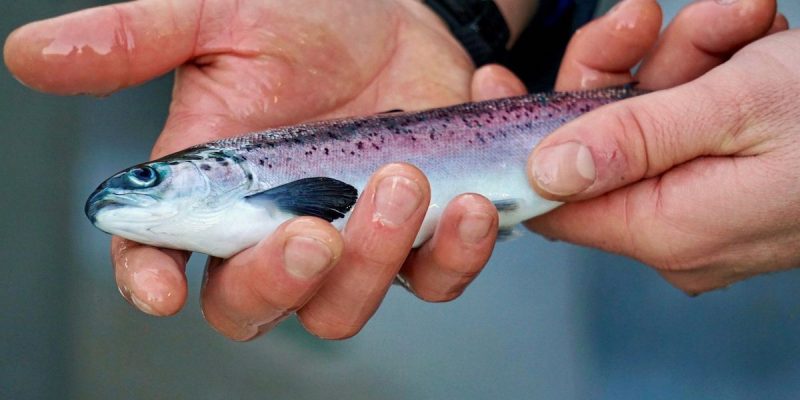UBC, Mowi to study new salmon smolt strategy
Two million dollar project will help improve both the sustainability and productivity of BC’s salmon aquaculture industry, says DFO
By Fabian Dawson
SeaWestNews
Can bigger baby salmon survive better in ocean net pens to improve the sustainability and productivity of BC’s aquaculture industry?
To answer this question, the Government of Canada yesterday announced that it will providing about two million dollars to researchers at the University of BC (UBC) and fish farmer, Mowi, to come up with a BC-based solution for growing larger, more physiologically robust Atlantic salmon smolts before they are transferred to the marine environment.
A longer production period on land for smolts in freshwater recirculating aquaculture systems (RAS) could lead to reducing the amount of time farmed Atlantic salmon spend in marine net-pens.
Correspondingly, that means less exposure to naturally occurring sea lice and algae blooms in the sea water phase.
“This project will help to improve both the sustainability and productivity of BC’s aquaculture industry,” said the Department of Fisheries and Oceans (DFO) in a press statement.
The research grant is being awarded in the wake of a DFO report entitled “State of Salmon Aquaculture Technologies” , which evaluated new approaches for farming Atlantic salmon.
The study explored four technology options: RAS land-based closed-containment; floating closed containment; offshore technologies; and hybrid systems, which combine both land and marine-based systems.
The hybrid system, which involves extending the amount of time young fish spend in land-based hatcheries by up to eight months before being moved to ocean pens is particularly promising in the near-term for BC salmon farmers.
Last March, Norwegian researchers reported that problems with sea lice in salmon farms are making it increasingly cost-effective to on-grow smolts past 100g in land-based systems,
One of the ways salmon producers are tackling this, they explained, is by extending the land-based phase in the production: instead of releasing smolts of 100-150 g for on-growing in sea, the land-based phase is lengthened to produce post-smolts of up to 1,000 g before transfer.
“Results indicate that, in the case of no lice, on-growing of 100 g smolts is most cost-efficient. However, as lice costs are considered, the results clearly show that on-growing of post-smolts on land is profitable,” they concluded.
Currently, farmed salmon in BC hatcheries and grow-out facilities are very healthy and an average of 90% survive from entry into the marine cages through to harvest, said the BC Salmon Farmers Association (BCSFA).
The UBC/Mowi research grant was one of eight announced yesterday under the British Columbia Salmon Restoration and Innovation Fund (BCSRIF) by Bernadette Jordan, Minister of Fisheries, Oceans and the Canadian Coast Guard.
More than $10 million in funding will support research and monitoring activities, infrastructure upgrades to community hatcheries, and the development of strategies to enhance the sustainability of Pacific fisheries, she said.
Speaking at the Vancouver Board of Trade, Jordan said BCSRIF will be accepting new applications for funding from July 15 to September 15, 2020.
Funding is open to Indigenous communities, industry associations, environmental non-governmental organizations, commercial enterprises, and academic institutions. Investments through this program will help recover salmon habitat, benefit commercial and recreational fishing and aquaculture, as well as support science and research initiatives.
“We cannot have a strong ocean economy without healthy oceans. With three oceans and the longest coastline in the world, Canada has a real opportunity to both grow our economy and become a global leader in ocean conservation,” said Jordan.
(Image shows a salmon smolt that is double the size of those produced in most traditional hatcheries, courtesy of Scottish Sea Farms)
QUICK FACTS
- Canada’s oceans economy accounts for about $31.65 billion annually in GDP. This includes marine transportation, ship building, energy, tourism and recreation. All of these sectors provide opportunities and jobs to our coastal communities.
- Canada’s aquaculture industry in general currently provides 30,000 good middle-class jobs on all three coasts, mostly in coastal, rural and Indigenous communities.
- The Government of Canada has begun work to introduce Canada’s first-ever Aquaculture Act, with the aim of bringing more clarity and transparency to Canadians as to how aquaculture will be managed in order to achieve responsible and sustainable growth.
- DFO is committed to working with the Province and Indigenous communities to create a responsible plan to transition open net-pen farming in British Columbia. We will move forward using the best available science, evidence, and input to develop a plan for aquaculture in B.C. and will be exploring all options throughout this process.
- The BCSRIF is a 70 per cent federal, 30 per cent provincial cost-shared program.
RELATED STORY

